Introduction
Several (yet not a lot!) users all over the world have reported
PLL unlock problems with their TS-2000(X). Though in different conditions,
all had the symptom that within seconds RF output power drops,
and next the screen only shows a line of dots: ..................... instead of
the frequencies in use, and the speaker announces in morse the report: "UL"
(see also page 75 of the manual).
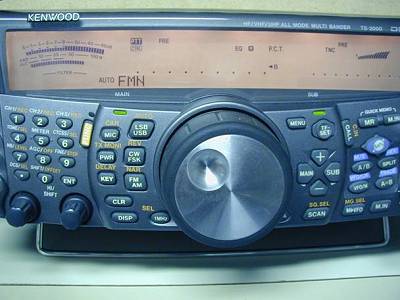
In some cases switching bands will bring the radio back to life, in some cases
the radio needs to be powered off/on first, and in some extreme cases the radio
needs to stay in power down mode for several hours (Roel, PA1DYK had this).
The conditions
The conditions / situation causing the radio to go in unlock mode were also
different:
PA1DYK had the radio quite undefined/random going into unlock.
PA3GUO had the radio always going into unlock if: (1) the 440MHz band was operated,
and (2) the radio was in transmit mode, and (3) while transmitting
the frequency was changed (either with the main dial or XIT), all at the same time. This happened
both in normal mode on either the main or sub band, as well as in satellite mode
(eg. AO7 where the TX/uplink band is 440MHz)
Measurements
As the reported problem (unlock) indicated one of the PLLs went out of lock, we started
measuring the VCO voltages and compared them to the expected values as given in the
service manual (pages 103,104).
The results were mostly in line with the expected values, but for PA1DYK not all:
PA1DYK checked against
the report of EA4BFK in the Yahoo Group of the Kenwood TS-2000
and noticed that like EA4BFK in his radio some PLLs had values that were not in
line with the expected values in the service manual. After adjusting, his radio
first seemed to have improved performance, but soon it turned out that the radio still
went into unlock, now the radio stayed even longer in unlock (needed to be even longer
in power off mode).
PA3GUO also checked the PLL voltages, and most were OK. Not OK were:
SUB1 PLL @220.000MHz, expected 1.0V or less, actual 1.935V and
SUB2 PLL @135.000MHz, expected 1.0V or less, actual 2.534V
Roel, PA1DYK had the same deviations as PA3GUO.
Problem solved for PA1DYK !
Help came from the USA Kenwood Service Center East. PA1DYK contacted them via email since
we are located on the other side of the world. Where the local European
service centers could not help us (or did not even reply to emails), the Manager of the
Service Center East, Steve, answered all our emails within two days and gave immediately
some very good inputs:
From his email:
There are a number of different things we have found on the PLL Board (X57-6060-XX /B11)
1. One is that the trimmer cap goes intermittant,
2. One that we resoldered the VCO and
3. Another that the shield plate was hitting the positive supply point. Attached is a picture
of the shield short proble. With you radio turning off that may be the problem.
Even though it seems unlikely that a short like this can be intermittant, it can:
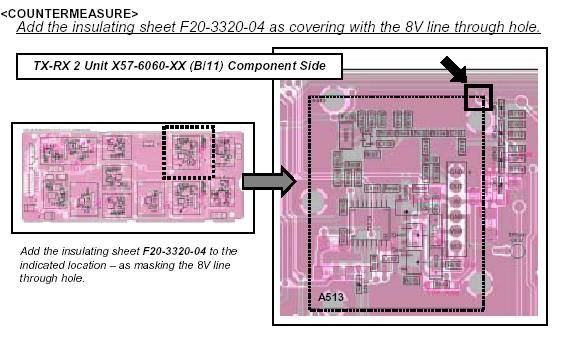
PA1DYK did steps 2 and 3, and on top of that noticed that there was a lot of raisin
on the contact points of the PCB and chassis on places where they should have provide ground
connectios and he removed this as well.
After this the radio of PA1DYK worked perfectly, no PLL unlock anymore !
Problem solved for PA3GUO !
Now it was my turn to get my radio repaired. Like PA1DYK I first wanted to do the
countermeasures suggested by Kenwood. I opened the radio and took out the PLL PCB:
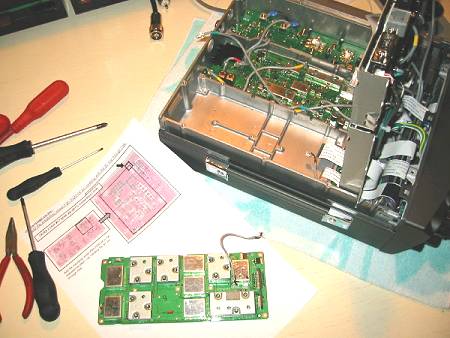
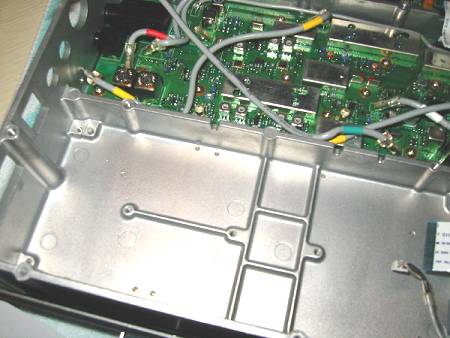
While inspecting the PLL / VCO PCB immediately we (PE1RXJ & PA3GUO) noticed the long
leads of the ceramic filter that were not cut off properly (see red circle), and were very close to create
a short between them and the chassis (ground). We have cut these leads back to an acceptable length.
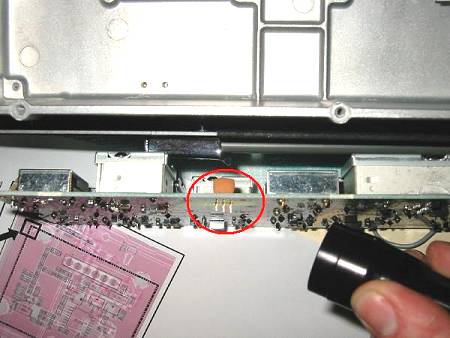

More leads were present that were too long, eg the coax connector ones, and all were cut.
Next some raisin was removed from ground tracks and the chassis.
As indicated by Kenwood we then lifted unit X57-6060 to prevent the short between the 8V thru hole
and the chassis of the VCO happening.
One solder cat whisker was removed from a VCO solder connection.
Just to make sure, we then made from plastic a foil that would prevent any short between the
PCB solder points and chassis, for the photo we put a blue color at the borders:
(note that we made a cut to ensure ground connections in the middle of the PCB still make contact)

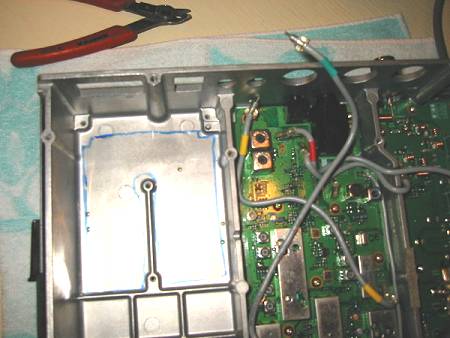
Unfortunately, after putting the radio together again, the PLL unlock still happened.
Again Kenwood Service Center East helped out (thanks again Steve !):
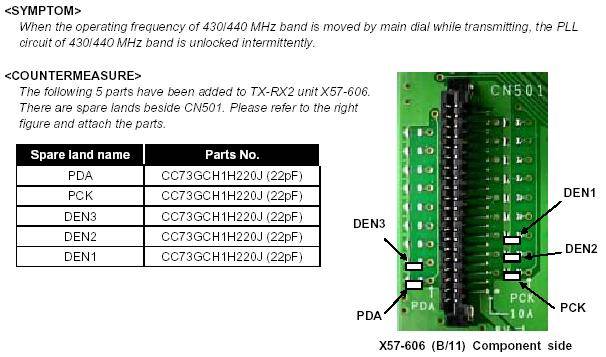
Now - this modification I actually never did. The symtom described by Kenwood perfectly matched the
symptoms my radio had. But while opening and closing the radio one more time (I had accidentally put
one of the coax cables back into the wrong connector...), and re-positioning the coax cables somewhat,
the whole PLL unlock problem disappeared !
What I did was positioning the coax between the components on the PCB, somewhat different as before,
yet still random. Most likely this impacted the amount of RF radiation into the other circuits,
eg the internal communication bus, even such that adding the de-coupling capacitors as described in the Kenwood
countermeasure, is no longer needed. In my case the radio never went into unlock mode anymore.
If it ever comes back though, I will implement the countermeasure of Kenwood given above.
But for the time being I leave it as is. The radio works great, I simply can not get it in unlock
anymore - and I tried very hard !
Note:
The PLL voltages as discussed above are still as before. That is, the SUB1 and SUB2 PLL have both
still their values deviating from the expected values given in the service manual, but we believe this has no
real relation with the PLL unlock problems and we left them as is.
Conclusions
To us it seems that:
1. for an early batch of radios (ours were on of the very early ones) there
have been some quality issues in the production (the long leads, raisin etc)
2. a PCB design error was made and a simple countermeasure is available (the VCO short)
3. RF radiation into the internal I2C communication bus (refer to the C's to be added) causes the PLL to go into unlock as well (or does the CPU only believe so, but in fact it is not?).
Most HAMs do not resolve these themselves, but ship their radio to Kenwood.
We did it ourselves, and honestly, it was a pleasure working on such an professionally designed
radio with rather advanced design techniques. From the Kenwood design methodologies
(mechanically especially) we learned a lot for our own (home made) projects.
Secondly, although we could not have done without, Kenwood was able to provide help via email,
and has clearly a well set up database for reported problems including countermeasures.
Finally, we are extremely thankfull to the manager of Kenwood's Service Center East for his help - great job Steve !
Disclaimer
Trying the modifications described in this article on your own equipment, is on your own risk.
Performing modifications of some equipment may be a violation of local laws.
If you have any doubts, do not perform the modification. This article is not written nor approved
by Kenwood. PA3GUO nor PA1DYK will assume any responsibility.
|
